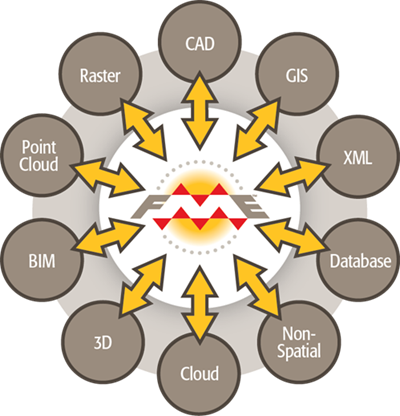FME Desktop can greatly assist with data integration by enabling users to efficiently combine, transform, and harmonize data from various sources and formats into a unified, usable dataset. Here are some specific ways it supports data integration:
1. Support for Multiple Data Formats
FME Desktop supports over 450 different file formats, such as GIS, CAD, XML, JSON, as well as databases, spreadsheets, and more. This versatility allows it to integrate data from diverse systems and platforms, removing barriers typically caused by incompatible formats.
2. Data Transformation
FME Desktop offers more than 500 transformers, which are tools designed to modify, clean, and validate data. These transformers help users standardize, enrich, or restructure data, making it possible to seamlessly integrate datasets that have varying structures or schemas.
3. Data Validation and Cleansing
FME Desktop allows users to identify and fix data inconsistencies during the integration process. Users can apply filters, validation checks, and transformation rules to ensure the data being integrated is accurate, clean, and conforms to the required standards.
4. Spatial and Non-Spatial Data Integration
FME Desktop excels in combining spatial (geographic) and non-spatial data. This is particularly useful in industries like GIS, where data from CAD drawings, satellite imagery, or database systems needs to be integrated for spatial analysis and visualization.
5. Automating Data Integration Workflows
Users can create automated workflows in FME Desktop to streamline recurring data integration tasks. These workflows can be scheduled or triggered to run automatically, ensuring that integrated data is updated regularly without manual intervention.
6. Coordination Across Systems
FME can act as a bridge between different data systems, facilitating communication between platforms like cloud services (e.g. AWS, Google Cloud), databases (e.g. PostgreSQL, Oracle), and other enterprise systems. This capability enables the integration of data from disparate sources into a unified environment for analysis and decision-making.
7. Spatial Data Manipulation
FME Desktop is particularly strong at integrating spatial data by converting projections, handling coordinate transformations, and managing geometry. This helps merge geographic datasets with attribute data from other systems, providing deeper insights.
8. No-Code Environment
FME’s visual, drag-and-drop interface makes data integration accessible even to users without programming skills. Complex workflows can be designed without writing code, making it easier for teams to collaborate and integrate data efficiently.

